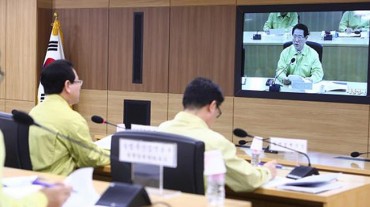
Korean-Japanese 3D artist Choi Jae-eun held a press conference at the Seoul Museum of History on October 25, during which she revealed the inspiration that led her to begin the ‘Dreaming of Earth’ project, a DMZ-based floating garden manifested through the collaborative efforts of a global constellation of artists. (Image: Yonhap)
SEOUL, Oct. 25 (Korea Bizwire) – 3D artist Choi Jae-eun held a press conference at the Seoul Museum of History on October 25, during which she revealed the inspiration that led her to begin the ‘Dreaming of Earth’ project, a DMZ-based floating garden manifested through the collaborative efforts of a global constellation of renowned artists.
Choi explained that the idea first started to form in her mind when she learned that the DMZ, the de-militarized zone dividing North and South Korea and an enduring symbol of the civil war that resulted in a lasting partition, was now teeming with wildlife, so much so that it had now been designated as one of the world’s most pristine conservation areas.

Armed with this knowledge and a sense of purpose derived from the desire to replicate the DMZ’s metamorphosis from an arena evoking memories of death into a thriving bastion of life, Choi replied that she set to work in 2015 with plans of the aforementioned floating garden along with a walking path, pavilions, a seed bank and a ‘knowledge bank’.(Image: Yonhap)
Armed with this knowledge and a sense of purpose derived from the desire to replicate the DMZ’s metamorphosis from an arena evoking memories of death into a thriving bastion of life, Choi replied that she set to work in 2015 with plans of the aforementioned floating garden along with a walking path, pavilions, a seed bank and a ‘knowledge bank’.
The floating garden being her first priority, Choi estimated its length at 20 km, and envisioned it as a makeshift bridge connecting North and South Korea. With this in mind, she decided to reach out to Japanese architect Shigeru Ban, a former winner of the prestigious Pritzker Architecture Prize, to join her in her new venture.

Choi explained that the idea first started to form in her mind when she learned that the DMZ, the de-militarized zone dividing North and South Korea and an enduring symbol of the civil war that resulted in a lasting partition, was now teeming with wildlife, so much so that it had now been designated as one of the world’s most pristine conservation areas. (Image: Kukje Gallery)
What Choi soon realized was that she was not alone in finding merit in her ‘Dreaming of Earth’ project. Soon, a who’s who list of artists and architects from diverse backgrounds and countries became involved in the floating garden, elevated three to five meters above the ground. Korean architect Seung Hyo-sang and Choi herself provided designs for the structures in the garden, while contemporary artists Olafur Eliasson, Tadashi Kawamata and Lee Ufan took care of the pagodas.

In a decision befitting the spirit of the project, Choi opted to leave five of the 12 structures and one of the three pagodas undesigned, designating them as the canvas for North Korean artists in the future. (Image: Yonhap)
In a decision befitting the spirit of the project, Choi opted to leave five of the 12 structures and one of the three pagodas undesigned, designating them as the canvas for North Korean artists in the future.
The organizer of the event praised Choi’s garden, saying ‘Dreaming of Earth’ was an artistic project which revives the memories of the history of the DMZ, and is a symbol of the drive for peace and life over destruction.
S.B.W. (sbw266@koreabizwire.com)






